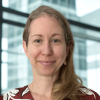Tuesday afternoon’s session was standing room only as representatives from various biopharma companies presented on their work to improve the efficiency and quality of AAV production.
Ballroom 3 at the Baltimore Convention Center was standing room only Tuesday afternoon at the annual meeting of the American Society of Gene & Cell Therapy. Several speakers took to the stage in succession to discuss ongoing efforts to improve adeno-associated virus purification and yield, aiming to improve both the safety and quality of these workhorse vectors of gene therapy.
First up was Pranav Mathur of the San Diego–based firm Cirsium Biosciences. Mathur talked about the company’s efforts to develop plant-based manufacturing processes for adeno-associated viruses (AAVs).
AAV manufacturing is 15 years from where monoclonal antibodies are, Cirsium CEO Daniel Gibbs told BioSpace earlier in the day. And while that lag time is not unexpected considering that monoclonal antibodies entered the biopharma scene well before cell and gene therapies (CGTs), Gibbs said that improvements to AAV manufacturing must outpace advances in producing monoclonal antibodies.
“[We have to] take those learnings and go exponentially faster,” he said. Not only will this improve the safety and quality of gene therapies, it should help improve access to these novel therapies. If the field doesn’t prioritize equitable access, “at some point it’s going to be a roadblock.”
The session continued with Spark Therapeutics’ Ohnmar Khanal, who emphasized the highly heterogeneous nature of AAVs. One challenge in increasing yield is purification, she noted, particularly separating empty and full capsids during production so patients receive those vectors carrying the therapeutic DNA. In addition to lacking the DNA that serves as the basis of a therapy, empty capsids are also structurally different, and “these differences really come into play in how empty, full and other variants are retained.” It’s critical to retain as many full capsids as possible while eliminating the empty ones, of which there are many more in the early stages of production.
At Solid Biosciences, senior principal scientist Xiaofei E and her colleagues are also working to increase AAV yield, with a focus on preventing transduction. E presented results from the company’s experiments with an additive known as brefeldin A, showing that it increased AAV yield in HEK293 cells two-fold or more, in large part due to the inhibition of transduction. “Quality was also up,” she noted.
Oxford Biomedica’s Alex Meola also discussed the use of additives to help isolate the full capsids from not only empty capsids but from a third group that includes a mixture of empty and DNA-containing capsids. “Not all empty capsids are created equal,” he noted, but the company’s proprietary additive combined with the use of anion-exchange chromatography (AEX), which uses AAVs’ positive charge to separate the vectors from impurities during production, was able to increase yield.
Johanna Weizenegger of ASCEND Therapeutics, which, like Oxford Biomedica, offers AAV services to biopharma companies, also spoke about AEX to remove impurities during AAV manufacturing, in its case removing more than 50% of impurities, and sometimes up to 90%.
There’s a “balance between yield and quality,” Thuy Linh Do, senior associate in gene therapy at Roche, said during her presentation. She specifically discussed the company’s efforts to optimize pH conditions and acidic hold time before neutralization. “The advance in this one step will contribute to the overall advancement” of AAV manufacturing, she said.
Jef Akst is managing editor of BioSpace. You can reach her at _jef.akst@biospace.com_. Follow her on LinkedIn and Twitter @JefAkst.






